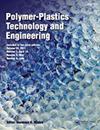Mechanical and Gas Barrier Properties of Poly(L-Lactic Acid) by Plasma-Enhanced Chemical Vapor Deposition of SiOx
Q2 Materials Science
引用次数: 5
Abstract
ABSTRACT In this work, poly(L-lactic acid) film was coated with SiOx by the plasma-enhanced chemical vapor deposition with different deposition times. Compared with the neat poly(L-lactic acid) film, the oxygen (O2), carbon dioxide (CO2), nitrogen (N2), and water vapor permeability of the poly(L-lactic acid)/SiOx60 film (depositing for 60 min) decreased by 40.7, 30.6, 58.7, and 53.4% at 25°C, respectively. After treated by the SiOx deposition, the gas permselectivity of the poly(L-lactic acid)/SiOx60 film, such as α(CO2/O2), α(O2/N2), and α(CO2/N2), increased by 17.2, 43.9, and 67.5% at 25°C, respectively. In addition, Young’s modulus and tensile strength of poly(L-lactic acid)/SiOx60 film increased by 107.2 and 49.3%, respectively. Moreover, the poly(L-lactic acid)/SiOx60 films still kept good toughness with an elongation at break of 50.7%. GRAPHICAL ABSTRACT等离子体增强化学气相沉积法制备聚l -乳酸的力学和气体阻隔性能
本研究采用等离子体增强化学气相沉积方法,在不同沉积时间下对聚l -乳酸薄膜进行SiOx涂层。与纯聚l -乳酸膜相比,聚l -乳酸/SiOx60膜(沉积60 min)在25℃下的氧(O2)、二氧化碳(CO2)、氮(N2)和水蒸气渗透率分别降低了40.7%、30.6%、58.7%和53.4%。经SiOx沉积处理后,聚l -乳酸/SiOx60膜在25℃时的气体选择性,如α(CO2/O2)、α(O2/N2)和α(CO2/N2)分别提高了17.2%、43.9%和67.5%。此外,聚l -乳酸/SiOx60薄膜的杨氏模量和拉伸强度分别提高了107.2和49.3%。此外,聚l -乳酸/SiOx60薄膜仍保持良好的韧性,断裂伸长率达50.7%。图形抽象
本文章由计算机程序翻译,如有差异,请以英文原文为准。
求助全文
约1分钟内获得全文
求助全文
来源期刊

Polymer-Plastics Technology and Engineering
工程技术-高分子科学
CiteScore
1.71
自引率
0.00%
发文量
0
审稿时长
4 months
 求助内容:
求助内容: 应助结果提醒方式:
应助结果提醒方式:


